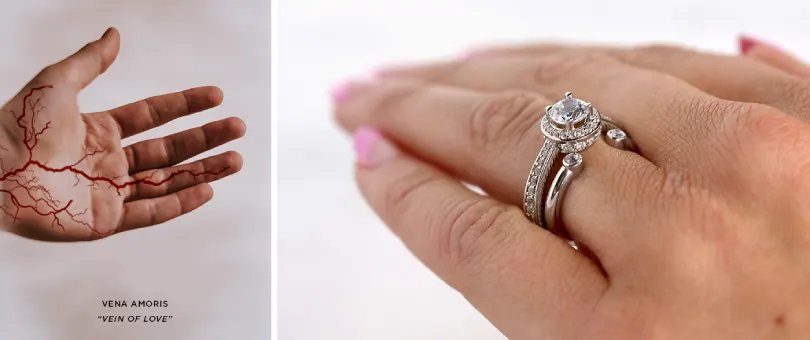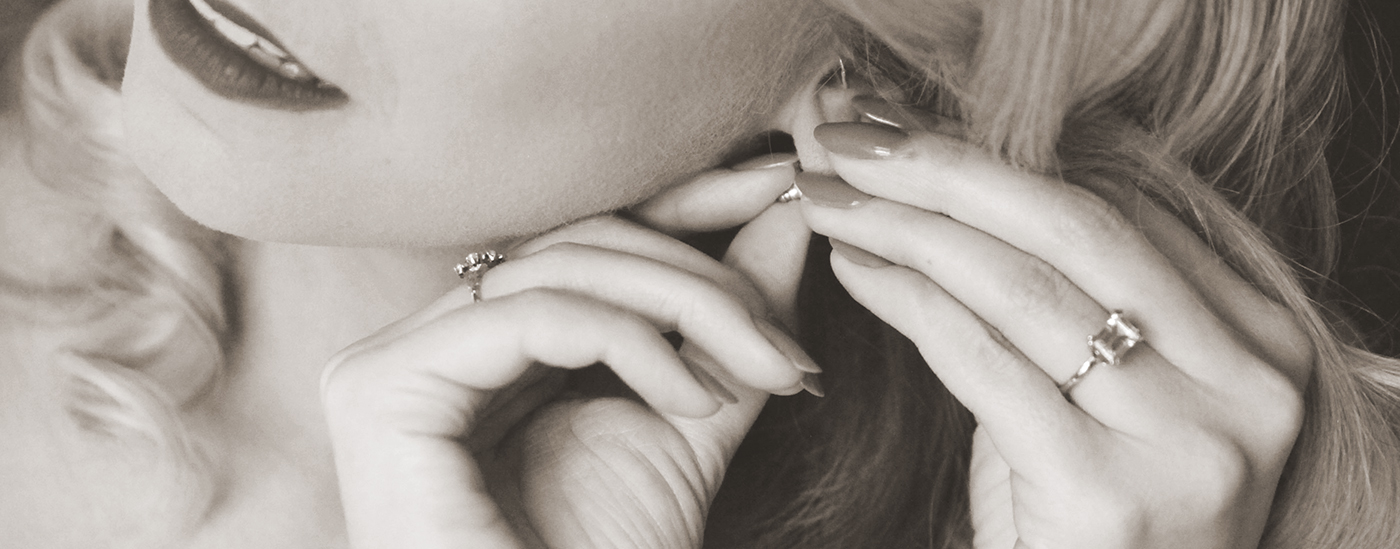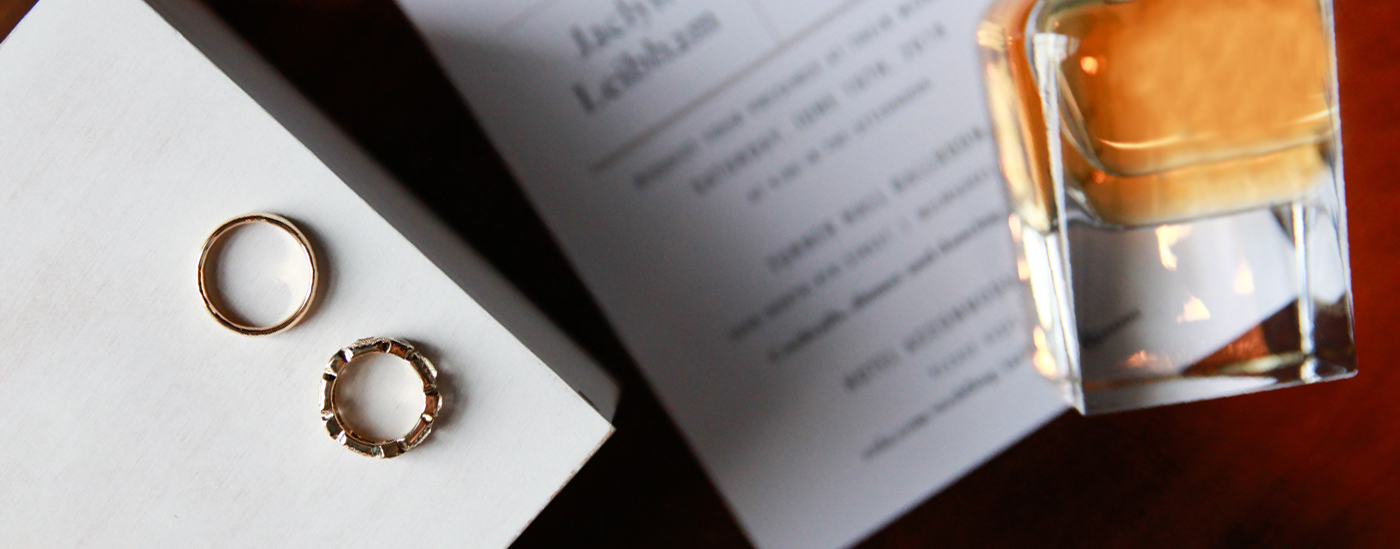Where to Wear Your Engagement Ring: A Comprehensive Guide
November 8th, 2023 / Alese Oldenburg

Where to Wear Your Engagement Ring
Whether your sweetheart opted for the beachy sunset proposal, the starry picnic engagement, or the romantic dinner that culminated in the popping of the question and the champagne bottle, there was most likely a sparkling engagement ring involved.
While the momentous occasion may be over, there are several little moments you can still enjoy with your jeweled band. But where exactly on your hand is your new adornment best worn?
In Western tradition, an engagement ring is worn on the fourth finger of a fiancée’s left hand, commonly referred to as the ring finger. But once your wedding day has come and gone, where can you wear your ring to still show off its dazzling shine? In this guide, we’ll explore engagement ring etiquette before, during, and after your special day.
The Simple Answer
Where do you wear your engagement ring vs. wedding ring? Simply, your engagement ring (and, later, your wedding ring) is worn on the fourth finger of your left hand.
The roots of this tradition have been traced back to the people of ancient Rome who believed that this left hand ring finger contained a vein that ran directly to the heart. This vein was called the Vena Amoris, which translates to the Vein of Love.

Although modern science has shown that no such vein exists, the tradition of wearing rings on the fourth finger of the left hand persists in the United States and many other countries around the world.
Engagement Ring Before Your Wedding
Before your wedding, your engagement ring should rest on the place of honor—the ring finger of your left hand. However, there are different methods to flaunting (and protecting) your ring, such as:
- Some fiancées choose to wear their ring only when out in public
- Some fiancées choose to wear their beloved engagement ring all the time
- Some fiancées even choose to have two rings: one less expensive ring for public wear (sometimes called a travel ring) and their real engagement ring, which is worn at home or during special occasions

Engagement Ring On Your Wedding Day
The tradition of giving and wearing a wedding ring to symbolize marriage began in Egypt almost 5,000 years ago. The circular shape of the ring is intended to represent:
- Eternity, with no beginning or end, just like the couple’s enduring eternal love for one another
- A gateway to everlasting love, specifically the center of the ring
Typically, you and your betrothed exchange wedding rings during your wedding ceremony. You’ll place the wedding bands on each other’s left ring finger after saying your vows.
But this begs the question, where do you put your engagement ring during the ceremony?

Traditionally, most soon-to-be betrotheds wear their wedding bands closest to their hearts. In other words, the wedding band will sit beneath the engagement ring on your ring finger.
As such, before your ceremony, it’s best to take off your engagement ring completely. However, some brides will simply move the engagement ring to their right hand’s ring finger during the proceedings. Then, following the vows, they can slide the ring back on top of the wedding band.
However, sizing may present a challenge for some since it can be common to have slightly larger ring sizes on your right hand. Nonetheless, your engagement ring should fit both hands, as long as your ring sizes are within a quarter-inch of each other.
If your ring won’t fit on your opposite hand or you decide you just don’t want to take your engagement ring off, it’s completely acceptable to place the wedding band above your ring and switch them around after the ceremony if you so choose.
Engagement Ring After Your Wedding
Most people choose to wear their wedding band under their engagement ring, but this is less about tradition and more about personal preference. To that end, when it comes to how to wear a wedding ring set, we recommend:
- Traditional – With the wedding band on the inside and the engagement ring on the outside
- Reversed – With the wedding band on the outside
- Opposite – With the two rings on opposite hands
- Special – Wear your wedding band by itself and only wear your engagement ring for special occasions
- Stacked – Sometimes a bride chooses to incorporate multiple wedding bands that can stack to create a more unique and eye-catching wedding jewelry set for the modern bride
- Soldered – Some brides even choose to solder the engagement ring and wedding band together, making a single piece of jewelry representing the marital bond
Breaking the so-called rules of engagement rings allows you to make stylistic choices that match your personal preferences and lifestyle. In other words, when it comes to where to wear an engagement ring, you don’t have to be conventional. It’s not uncommon to see men’s engagement rings either.

Engagement Rings in Western Tradition
Today, an engagement ring is considered a symbol of the eternal love two people have for one another and their intention to wed. But the history of engagement rings was not always romantically sentimental.
Historically, engagement rings were used to signify various practical and legal conditions of the relationship, representing more than just a couple’s love for one another and their promise to wed.
Over many centuries, wearing rings has held meaning that continues to evolve with the values and culture of the times. To that end, engagement rings have held three prominent purposes throughout history:
- An indicator of status – Although marriage today is seen as a mutual decision between two people in love, that was not always the case. In ancient Rome and other civilizations, marriages were arranged as a transaction between families, often to improve the status of the less fortunate family. The ring was introduced as a symbol of the legally binding agreement between the families, and it indicated that the woman had become her husband’s property. At the time, the rings were made of iron and had no embellishments. However, some would wear gold rings with certain features or inscriptions on them to represent their husband’s wealth. Not surprisingly, the Romans were also the first society to implement legal regulations around monogamy, dowries, and even divorce.
- A reminder to be faithful – During the Renaissance period, puzzle rings were invented as a way to know if a partner had been unfaithful, although they were most often worn by wives. It is said that these rings featured multiple pieces that formed a single band, interlocking in such an intricate way that if it were removed from the finger it would fall apart and a woman would not be able to put it back on. This would thus notify her husband that she had been unfaithful.
- A sign of the times – The Victorian era is when we see elements of design added to engagement rings and wedding bands. The people of this time period were known for being sentimental and took much more care in creating rings that were beautiful, not just functional. It was not uncommon to see rings featuring elaborate decorations such as hearts, flowers and colorful gemstones. Prince Albert even proposed to Queen Victoria with a ring depicting a serpent with an emerald head. Victorians are also responsible for making diamond rings more accessible to the middle class as a result of the diamond rush in the mid-19th century. Although the stones had long been a favorite of those in high society, the trend became more popularized at this time. As styles and fashion have changed and evolved, so too have the designs of engagement rings.
Roots of Diamond Engagement Rings
Historically, engagement rings became popular many years after the wedding band. It’s believed that the first engagement ring was used in 1477 by Archduke Maximilian of Austria as a present to his fiancée, Mary of Burgundy. The ring featured an array of long diamonds shaped into an “M.”
Although many different stones can be used in an engagement ring, diamonds have long been the stone of choice for several reasons:
- Durability – For this reason, diamonds symbolize a couple’s eternal love and commitment
- Uniqueness – No two diamonds are the same, just as each couple shares their own unique love story
However, even with multi-faceted meaning and tradition, an increasing number of couples opt for both wedding and engagement ring styles that feature alternative stones as the centerpiece of their rings. Let’s take a look at a few celebrity choices:
- Kate Middleton, the Duchess of Cambridge, wears a 12-carat Ceylon blue sapphire engagement ring
- Emma Stone wears a pearl and beige-gold ring
- Katy Perry wears a pink-and-diamond daisy engagement ring
- Anna Paquin wears a moonstone ring
- Halle Berry wears a rustic gold and emerald engagement ring
A lab-created diamond simulant, like the Nexus Diamond™ alternative, may also be an excellent option as you can get the look, wear, and feel of a diamond for a fraction of the cost.
Start Your Tradition with a Nexus Diamond™ Alternative
Engagement rings and wedding bands are steeped in history and tradition, which might make you feel like there’s a set of rules to follow when wearing your engagement ring. However, the truth is, you have the freedom to wear your engagement ring any way you like—and design it in a way that reflects you and your partner perfectly.
To that end, Diamond Nexus’ lab-created diamond stimulants may be the perfect adornment for your engagement ring.
Our beautiful diamond alternatives are inexpensive, ethical, and eco-friendly because they’re not mined, making them an ideal choice for those looking for a gorgeous emblem that lasts a lifetime.
Sources:
- Elle. The Evolution of Engagement Rings Through The Years.
https://www.elle.com/fashion/accessories/g32710699/engagement-rings-history/?slide=1 - Vanity Fair. Band for Life: The History of Wedding Rings.
https://www.vanityfair.com/london/2018/07/band-for-life-the-history-of-wedding-rings - Brides. The Surprising History of Engagement Rings.
https://www.brides.com/story/history-of-the-engagement-ring - Marie Claire. 15 Celebrities Who Skipped Diamond Engagement Rings For Something a Little More Non-Traditional.
https://www.marieclaire.com.au/celebrity-non-diamond-engagement-rings
*Here at Diamond Nexus, we strive to provide valuable information while being clear and honest about our products. The Nexus Diamond™ alternative is a patented lab created diamond simulate that, among all simulants, most closely imitates the look, weight and wear of a diamond, with two exceptions – it is absolutely perfect in every way, and it costs significantly less. Price points and environmental facts expressed in this blog were taken from popular online retailers and may vary. Learn more about the environmental impact of mining by visiting our blog: blog.

